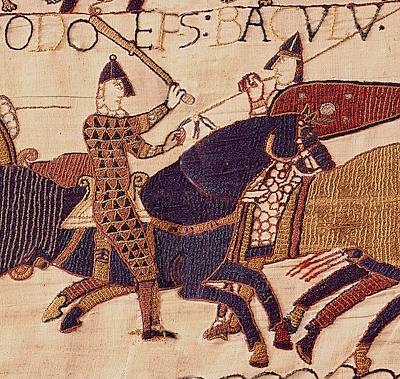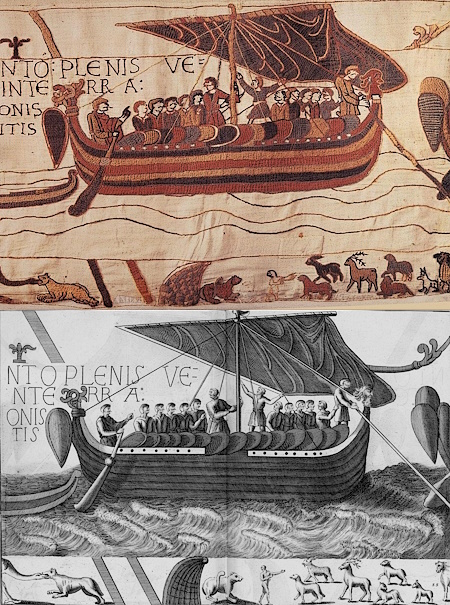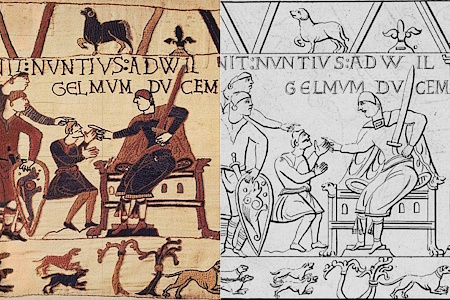The Bayeux Tapestry
The Bayeux Tapestry is not a tapestry at all, but an embroidery, stitched in ten colours of woollen thread on a linen base, approximately 20 inches wide and, as it is now, 225 feet long. It depicts, from a Norman perspective, the events leading up to, and culminating in, the battle of Hastings (14th October 1066). The Tapestry ends, rather raggedly, apparently showing defeated Englishmen being chased from the battlefield, but the true end is missing – presumably it would have pictured the coronation of William ‘the Conqueror’ (25th December 1066).
There is no certainty, but the most widely held scholarly belief is that the work was commissioned by William’s half-brother, Odo, bishop of Bayeux and earl of Kent, and that it was made in England – William of Poitiers notes (II, 42): “The women of the English people are very skilled in needlework” – probably before 1082, when Odo fell from favour. Odo’s new Bayeux Cathedral was dedicated in 1077, and it is frequently suggested that the Tapestry was produced for display on that occasion. It was certainly at Bayeux Cathedral four centuries later. Its existence is first recorded in 1476 – in an inventory of the treasury of the cathedral, which says that it was hung around the nave each year “on the day and through the octaves of the relics”, i.e. from 1st to 8th July. How long this tradition had been going on before 1476 is not indicated.

The Tapestry was brought to general notice in 1729, by the Benedictine scholar Bernard de Montfaucon, who, in Volume 1 of his Les Monumens de la Monarchie Françoise, presented glamourized engravings of about the first 30 feet of it. The engravings were based on a drawing found in the papers of Nicolas-Joseph Foucault (d.1721) in 1724. (Foucault had been intendant of Normandy between 1689 and 1704.) At the time it was discovered, it wasn’t known what the drawing depicted – could it be a tomb relief, a fresco, stained glass, or maybe a tapestry? Montfaucon’s research revealed it to be:
… a strip of tapestry preserved in Bayeux Cathedral, & which is exhibited on certain days of the year.

Montfaucon, who was based in Paris, sent Antoine Benoît, “one of the most skilled draughtsmen of this time”, to Bayeux to make a faithful drawing of the rest of the Tapestry, engravings of which, showing the work’s “coarse and most barbarous style”, were published in Volume 2 (1730).

The Tapestry came close to destruction during the French Revolution. In 1792 the military were going to use it as a tarpaulin, to cover wagons. It was rescued, in the nick of time, by a local lawyer. A couple of years later, newly appointed art commissioners prevented it being chopped-up to decorate a carnival float.
English antiquary Hudson Gurney visited the Tapestry in 1814:
… it was at the Hotel of the Prefecture. It was coiled round a machine, like that which lets down buckets to a well; and I had the opportunity of drawing it out at leisure, over a table.‘Observations on the Bayeux Tapestry’, Archaeologia Vol.18, 1817
Dawson Turner, another English antiquary, in a letter sent from Bayeux in 1818, writes:
The tapestry is coiled round a cylinder, which is turned by a winch and wheel; and it is rolled and unrolled with so little attention, that if it continues under such management as the present, it will be wholly ruined in the course of half a century. It is injured at the beginning: towards the end it becomes very ragged, and several of the figures have completely disappeared. The worsted is unravelling too in many of the intermediate portions. As yet, however, it is still in good preservation, considering its great age, though, as I have just observed, it will not long continue so.A Tour in Normandy Vol.2, Letter 27, 1820
The Tapestry subsequently underwent major restoration – the synthetic dyes used for the thread date this post-1860. It is now a museum exhibit at Bayeux[*].